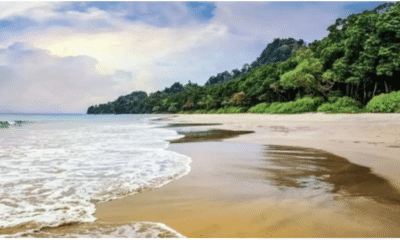
|
Getting your Trinity Audio player ready...
|
(The article was originally published in Indian Express on March 2, 2024 as a part of Dr Madhav’s column titled ‘Ram Rajya’. Views expressed are personal.)
Agalega is a tiny speck in the vast waters of the Western Indian Ocean. This atoll, comprising two islands, North and South Agalega, separated by a short channel not wider than 200 metres, is just 25 square kilometres in area. From the air, it looks like an exclamation mark. Many strategic observers in the world were sceptical when the prime ministers of India and Mauritius, Narendra Modi and Pravind Jugnauth respectively, announced a Memorandum of Understanding (MoU) in 2015 to develop this atoll.
Although it existed on the radar of agencies like the CIA, which suspected, without any evidence, that the erstwhile USSR had plans to capture it and turn it into a naval base, not many bothered about this piece of land in a remote corner of the Indian Ocean. Even the Mauritius government, to which Agalega belonged, used to dispatch a shipload of essential commodities to its less than 300 inhabitants, almost all Creoles, only once in three months. M V Trochetia, the ship that brought these commodities to service the islanders, would anchor deep in the waters as no port facility existed on the island, while small vessels would make dozens of rounds to shift the cargo back and forth. No medical or educational facility existed for the people living there.
This atoll, located 684 miles (1,122 km) northeast of mainland Mauritius was once a slave plantation colony. The only town on the island is called Vingt-Cinq — meaning 25 in French — referring to the number of lashes the slaves would receive as punishment. The 12 km-long and 2 km-wide northern island has a small airstrip which used to be occasionally visited by Coast Guard planes and helicopters.
While signing the MoU in 2015, the two prime ministers announced that the 800-metre long airstrip, capable of landing light aircraft, will be developed into a full-length airfield that can receive larger planes. They insisted that the objective was about “setting up and upgradation of infrastructure for improving sea and air connectivity at the Outer Island of Mauritius which will go a long way in ameliorating the condition of the inhabitants of this remote island.”
Some critics in the strategic world were not convinced and insisted that the real objective of the Indian government was to build a military base. Dozens of articles and reports followed, with some even alleging that Agalega was “a secret base, and India’s claim to power”. Some politicians in Mauritius too saw an opportunity to corner the prime minister. However, Prime Minister Jugnauth stoutly defended his decision, insisting that the project was intended to enhance the capabilities of the government in managing far-flung islands. He also clarified that “India would be allowed to utilise the facilities in Agalega subject to prior notification from the competent authorities of Mauritius.”
Eight years after the MoU, and amidst intense speculation, the two prime ministers met again, virtually, earlier this week and announced the opening of the upgraded 3-km-long airstrip that can handle bigger aircraft, and a harbour that can anchor big ships. Six civilian projects, including a medical facility and a school, were also inaugurated.
Both PMs highlighted the maritime significance of the initiative hinting, at a larger geo-strategic objective. While thanking Prime Minister Modi “for helping Mauritius realise such major transformational projects”, Jugnauth added that besides meeting the development objectives, they will also “significantly enhance the capabilities and capacities in marine surveillance and security”. Prime Minister Modi too, on his part, referred to the “traditional and non-traditional challenges” in the Indian Ocean region and described Mauritius as a “natural partner in maritime security”. “We are actively working to ensure security, prosperity and stability in the Indian Ocean Region. We are cooperating in all areas like monitoring of Exclusive Economic Zone, joint patrolling, hydrography, and Humanitarian Assistance and Disaster Relief,” he added.
Agalega thus entered the list of ports in the Indian Ocean that provide strategic access to India — dubbed by some analysts as the “necklace of diamonds” — as against the “string of pearls” ports that provide access to the Chinese. India already has a naval air station in North Andaman called INS Kohassa, and another near Port Blair called INS Utkrosh, which provide enough depth for the country’s military to monitor the Eastern Indian Ocean thoroughly. With the maritime empowerment of Mauritius through the Agalega project, India can expect to get enough cooperation from that country, “a natural partner”, in monitoring important ocean lines in the Western Indian Ocean too, including the crucial Mozambique Channel.
The Indian Ocean region has emerged as the axis of global power. The US and the UK, with the Diego Garcia base, and France, with Reunion Island, are already active in the region. China, too, joined them, investing heavily in spreading its tentacles. It built many assets in the Western Indian Ocean, such as the bases in Djibouti and Gwadar, and developed extensive influence over many leaders in Africa. For India, which depends on the Indian Ocean for almost 90 per cent of its imports and exports, growing Chinese activities in the region are a considerable challenge.
Besides, India, under Prime Minister Modi, nurtured the ambition of rising as an influential blue-water power and also the voice of the Global South. Befitting its current stature as a major regional power, Modi’s India wished to convey through the Agalega project that it too has arrived and is serious about its critical role as a net peace provider in the Indian Ocean region, and willing to brook no interference in managing it as a “zone of peace”.




